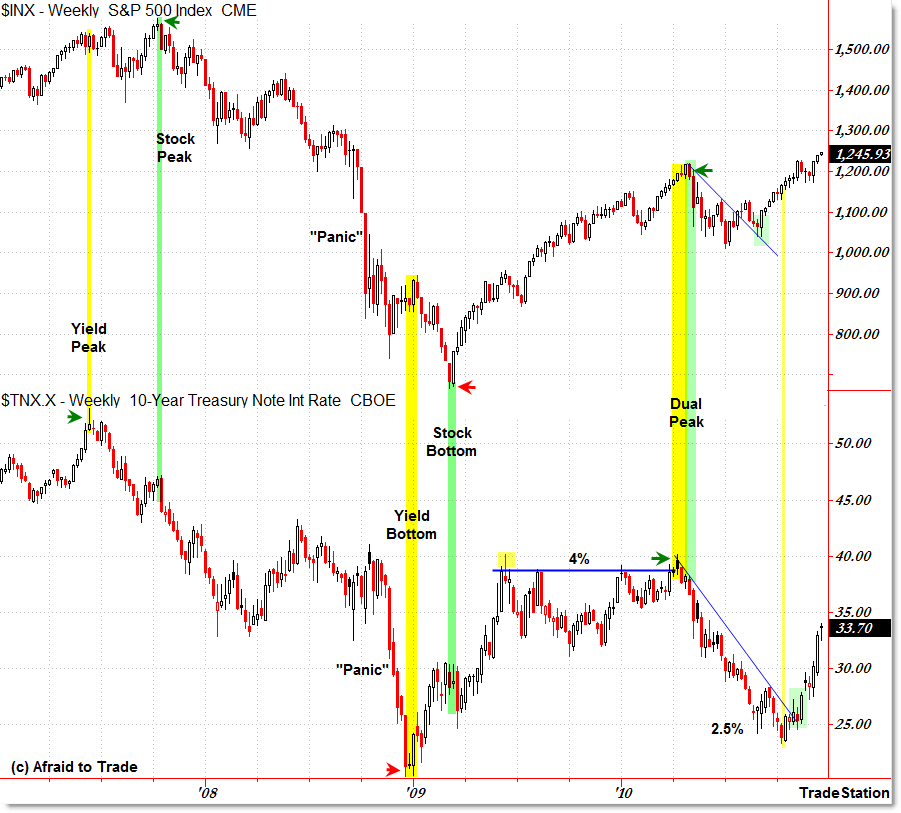Comparing Ten Year Yields and SP500 During Recession and Recovery
There’s something rather odd about the relationship between Treasury Yields and the S&P 500 over the last few months, as we’ll soon discover in the chart.
Let’s take a look at the past positive relationship from the start of the Recession through the current Recovery and make notes and observations along the way.

I always like to set the main-idea up when discussing a chart.
There’s two main ideas:
1. Ten-Year Treasury Note Yields (TNX) are strongly positively correlated (move in the same direction) with the S&P 500.
2. Treasury Yields have often shown a slight LEAD time (advance) at key turning points in the markets
Take a moment to see how these relationships have played out over the last 3 years or so.
Yields peaked at the 5% level in June 2007, ahead of the big peak in stocks in October 2007.
By the same token, Yields bottomed at the 2% level in December 2008, roughly three months ahead of the stock market bottom in early March 2009.
While that’s all well and good in the past, the relationship broke down slightly in 2009, with yields slamming into resistance at the 3% yield level and hovering there for the remainder of the year while stocks continued their rise.
Then, yields peaked for a fourth time exactly at 4% on April 5th, 2010 which was ahead of the stock market peak later on April 26th – again an advance turn in bonds.
From there, bond yields and stocks tumbled until both found recent bottoms, but THIS TIME stocks found their bottom in September (technically July) while yields tumbled under 2.5% to bottom in October.
From there, both rose strongly – quite powerfully actually – to where they are now, though stocks are at new recovery highs while yields clearly are not.
The charts are interesting, but there’s a classic Intervening Variable – the Fed’s stated “QE 2” policy, wherein the Federal Reserve actively seeks to drive down Treasury Yields by purchasing Treasury Bonds.
Remember, bond prices and yields are INVERSE, such that rising yields mean falling bond prices, and rising bond prices mean falling Treasury yields.
Investors can’t purchase YIELD but they can purchase bonds – thus the supply and demand relationship may make more sense if you look at prices instead of yields.
As in, when stock prices are RISING, investors typically sell ‘conservative’ bond positions to buy stocks, and vice versa, when stocks are falling, investors typically flee the risk in stocks to the safety in bonds.
Anyway, the Federal Reserve has created – or are trying to create – artificial DEMAND by purchasing bonds to drive yields lower.
So far, it’s slightly embarrassing to the Fed that since their announcement, yields have roughly surged from 2.5% to the recent key breakout above 3.0%.
If anything, it’s a classic example of investors “Buying the Rumor (that the Fed is likely to buy bonds in QE2) and then Selling the Fact (that the Fed actually IS going to buy bonds).”
Nevertheless, it is a confounding variable in the normally/traditionally positive relationship (correlation) between yields and stocks – or stated differently, stocks and bonds.
In recent history, Rising Stock Prices and Rising Treasury Yields have been the NORM.
The QE2 moves have affected the relationship, and its up to investors/traders now to see how much that relationship has been altered and what to do about it.
Of course, since yields and stocks are rallying sharply together (so far), it’s sort of a case of “No Harm, No Foul,” but do keep an eye on these two relationships for any further signs of stress, decoupling, or anything else … out of the ordinary.
Corey Rosenbloom, CMT
Afraid to Trade.com
Follow Corey on Twitter: http://twitter.com/afraidtotrade

Thanks for reviewing this. What is the relationship with gold, commodities, and the dollar? Also, slight typo in your blog: “rising bond prices mean rising yields.”
Thank you Terry! I corrected the error – guess I was trying to type too quickly!
The QE2 strongly affects those as well. It's probably best to think of it in the traditional “Risk On / Risk Off” logic. Gold, commodities, stocks are RISK ON while Bonds are usually RISK OFF. The Dollar is generally strongly inverse stocks, and is thus considered “RISK OFF” as well.
Phils stock world led me to your web page-WOW!
I have a great new source technical supports to enable my trading.
I have sent this web-site to all my trading buddies.
thanx again.
ED
i really appreciate it and thanks for sharing.
option trading tips
Hi Sir
You really share very appropriate blog and i often visit your blog and i get very useful and valuable point s form your blog. Really i want to thank to you a lot for posting.
nifty options